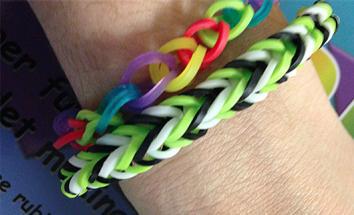If you are a parent of tweens and have not yet heard of Rainbow Loom, congratulations on being a unicorn who can read. Rainbow Loom—a plastic pegboard that comes with a hook, clips, and 600 brightly colored rubber bands—is the newest omnipresent Kid Fad. Use the hook to twist the tiny bands into Daedal patterns. Consult YouTube videos for instructions on the trickier ones: zippy chains, hexafish, triple singles, double braids, ladders, starbursts, sweethearts. (They even have a Double X!) The product is sort of like lanyards, sort of like Silly Bandz, sort of like a magical drug that turns children aged 8 to 14 into crazed arachnids. It is the reason kids’ arms are stacked with bracelets, which they give away and sell and trade the way we used to with pogs, Pokémon cards, Garbage Pail Kids, and Beanie Babies.
Parents love Rainbow Loom because they think it promotes creativity, quiet focus, fine motor skills, and digital literacy. Teachers hate it because they think students are “addicted” and “distracted” (the bracelets have so far been banned in two New York schools). Toy retailers covet it because more than 3 million $17-a-piece units have sold since the kits became available this summer, and that number was reported before the holiday shopping rush. And business reporters are inspired by the product’s Horatio Alger–like journey—by the crash-test engineer in his Michigan living room who set out to devise a compelling toy for his two daughters and ended up with a multimillion dollar company.
But you? How should you feel about Rainbow Loom?
I spent a week in a Rainbow Loom wormhole to find out.
* * *
Rainbow Loom is for ages “8 and up,” so while, as a 26-year-old female, I am not the target audience for the toy, I am not not the target audience either. In fact, much has already been made of Rainbow Loom’s broad appeal. It is the rare jewelry crafting kit that entrances boys as well as girls—one Chicago retailer estimated that around 40 percent of the looms he sells go to the former. In Time, Annie Murphy Paul writes that her son and his friends have embraced looming, upending the stereotype that boys prefer to throw and smash, while girls like to finesse and prettify. “Toy choice is the single most sex-typed behavior that children display,” Murphy Paul notes, so if Rainbow Loom has lured boys into the “pink aisle,” that’s a big deal.

Photo by Katy Waldman/Slate
Of course, eye-popping colors and swirly designs don’t have to connote girlhood. One mom speculated to the Christian Science Monitor that her son liked Rainbow Loom’s “gender-neutral packaging” and the fact that it uses “rubber bands rather than fluffy yarn or delicate materials.” But even if the toy amounts to a manlier take on Penelope’s art, it is still interesting to see, in a marketplace chock-full of “boy toys” draped in feminine signifiers for girls’ benefit, a “girl toy” presented as gender neutral. So the first thing I did when I received my kit in the mail was wave it in the face of my male co-worker.
“Do you hear … the call … of the Rainbow Loom?”
“Intriguing!” he replied. “But I used to knit all the time in college, so I’m already an outlier.”
That makes two of us. If women are supposed to love weaving complicated designs (preferably by candlelight, out of our own shining hair), I am more of a book person. This is not a humblebrag; I just prefer pastimes you can’t screw up.
But 8-year-olds do Rainbow Loom! How hard can it be? I started with the simplest schema in the Rainbow Loom cosmos, the “single pattern link,” because that was the one featured in the instruction manual that came with the package. It took me maybe 10 minutes after laying down my colors and picking up the hook to find even a halting rhythm. The bands kept snapping off the pegs and hitting me in the eye. With only the haziest understanding of the rules governing the art form, I struggled to retrace my steps after making an error (which happened a lot).
According to Cynthia Edwards, a psychologist based in Raleigh, N.C., kids in the Rainbow Loom age group are beginning to develop “executive function,” or the ability to plan and carry out complicated tasks. To them, following the mazy windings of a triple diamond stitch can feel like a fascinating new challenge. Rainbow Loom helped me realize that, at 26, I am not at all enticed by the prospect of planning and carrying out complicated tasks. Simple tasks for this girl, please! Yet over time, the crafting got easier. Though acolytes praise Rainbow Loom for sparking kids’ imaginations, becoming one with your loom is actually a pretty mindless process. The hypnotic clicking of the hook against the pegs becomes a lullaby. The world narrows. At first, I frequently put down my pegboard in order to make notes, but as my bracelet took shape, the stenography tapered off. (Need to pee, the last entry reads, like some doomed scribble out of Bram Stoker, but cannot get up.)
Anyway, once you complete your first Rainbow Loom bracelet, you expect some kind of celestial trumpeting to welcome you to the world of tween artisans. (And indeed the toy has been praised for making kids feel accomplished and competent.) But you must resist the urge to self-congratulate. Oh, you have far to go! It is time to put aside the instruction manual and venture into the belly of the whale: Rainbow Loom’s YouTube community.
In an article for Forbes, writer (and father) Jordan Shapiro argues that Rainbow Loom teaches kids to “mediate effectively between virtual and material realities.” That’s because, in order to execute the more complex designs, you need to consult the toy’s Internet oracles—tweens who have posted detailed “how-to” videos online. My personal favorites are “Ashley Steph” and “Parker’s Videos,” but the options are as staggering as the demand is real: Shapiro reports more than 969,500 monthly YouTube searches for “Rainbow Loom” in the U.S., not counting design-specific queries like “Rainbow Loom raindrop” or “Rainbow Loom fishtail,” of which there must be many.
The way the toy incorporates digital learning feels, to me, weirdly reminiscent of my adult life: I often use the Web to look up things like “how to open wine without a bottle opener” or “how to fold a hospital corner.” So I guess Rainbow Loom is “preparing” kids for that. But back to Ashley Steph. In the video I watched, one of the two girls behind the account is actually a terrific tour guide through the pied Rainbow Loom safari (except for occasionally when she needs to sloooow down.) She showed me how to select my colors, carry off my stitches, and fasten the diminutive c-clips that connected the two ends of my fishtail bracelet. Every so often a parent or sibling interrupted her while the iPhone camera rolled and she gave a polite answer before returning to the tutorial. Not once do viewers see Ashley Steph’s face—only her hands holding the loom or twirling the hook across the stretchy bands. Her videos aren’t vanity projects but acts of service. Soaking it in, I was impressed. Have kids always been so generous with their time and expertise, especially when it came to enlightening perfect strangers?
The sense of an online community flowering around Rainbow Loom gave me a glimmer of what we less-connected generations missed out on as kids. The Web itself is a pattern of interlaced users, and crafting with these semianonymous tweens made me feel a part of its warp and weft. The idea of digital literacy is really one of communication and collaboration—how do we train young people to use the information washing over them every time they go online? How do we teach them to work together in virtual space and in, you know, actual rooms? Maybe we should start by buying them all Rainbow Looms. (Just kidding, they all have them already.)
* * *
Yet Rainbow Loom is more than just “Internet-social”; it is real-world, face-to-face social, too. Like Tamagotchis or Crazy Bones, the bracelets have become wearable status markers. Kids trade them, make and take requests, and fashion them for their friends and siblings. One Slate colleague relayed a story from her sister-in-law, a math teacher: She’d noticed that all the popular girls in her class were suddenly talking to the nerdy boys. The teacher was flummoxed until she saw a flood of Rainbow Loom jewelry pour out of a shy kid’s backpack: He and his dorkier classmates were buying bracelets off the student royalty.

Photo by Katy Waldman/Slate
I was not keen to go hawk starburst key chains to sixth graders. But I did want to experience the social side of Rainbow Loom—which is how I found myself at a bar last weekend with two friends, one weaving kit, and no dignity. We decided to start with the fishtail pattern. After selecting our colors—this involved compromise—we took turns with the board (sharing), passing it around every three stitches or so (teamwork). It felt like the ideal context for the toy: Our hands were busy, but our minds were free to rove, and in the meantime, the elegant bracelet spun off the loom, as if chasing its own secret agenda.
This is a version of how I imagine women have done handicrafts for thousands of years. In the half-light of the bar, we discovered our communal rhythm; I glowed with a sense of connection to my fellow loomers. It was the pinnacle of what Rainbow Loom might mean for me, an undexterous female of 26, living in a wash of ephemeral text and screens. It was company. Process. Something solid in my hands.
But then hubris intervened. After we attracted the curiosity of the bartender, who comped us a round of drinks (in anticipation of a Rainbow Loom freebie, probably), we chose to attempt the hexafish. This is the hex-addled Devil Fish of tweencraft—a multipeg proposition that actually requires you to break apart and reconstruct your loom before you start. Once you’re finally working on the pattern, you can try to hold up your end of a conversation while impotently scratching at the briar patch of rubber bands before you, but it won’t go well, even if you aren’t already three sheets to the wind. About 25 minutes into the hexafish, our pegboard was a chromatic war zone of broken elastic, and we were all pretty much over the Rainbow Loom.
* * *
Throughout my week of Incessant Rainbow Looming, I kept expecting to feel addicted. I thought a moment would come where I realized I had to keep weaving or the universe itself would unravel. That didn’t happen. There were a few times—a staff meeting, a coffee date—that I remembered my loom in my bag and felt a bit of an itch. But I never became obsessed.
Of course, I’m not 9 and surrounded by friends and frenemies, siblings and crushes, all Looming around me. If I were, I can see how Rainbow Loom might suck you in and how, as these fads go, it’s got at least some value: a 9-year-old could probably use the ego boost of creation, the practice in carefully following directions. And I can see how a craftier person would delight in inventing new patterns and tweaking old ones. But Rainbow Loom’s most lasting legacy, for me, will have to be the zillions of gaudy rubber bands that have invaded every corner of my life. They’re in my purse, on my desk, between the keys of my keyboard. I found one in my hair this morning and am worried they will choke me in my sleep. I contemplated gathering them up and bringing them in for future loomers on the Slate staff. Finally, though, I just dumped them in the trash. We all have to grow up sometime—plus, if I’m writing about it, Rainbow Loom has only a few short months left before it’s officially uncool.
